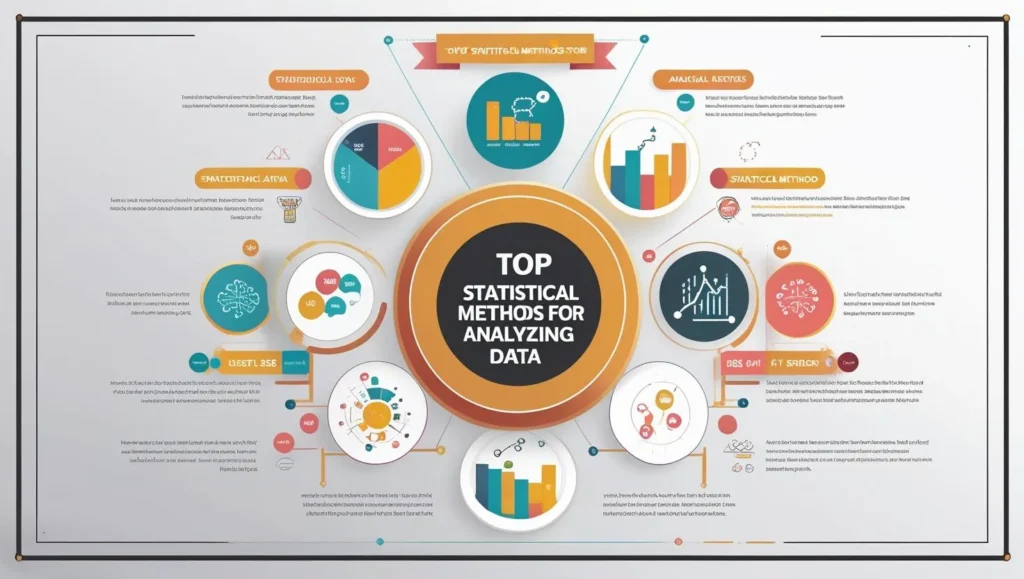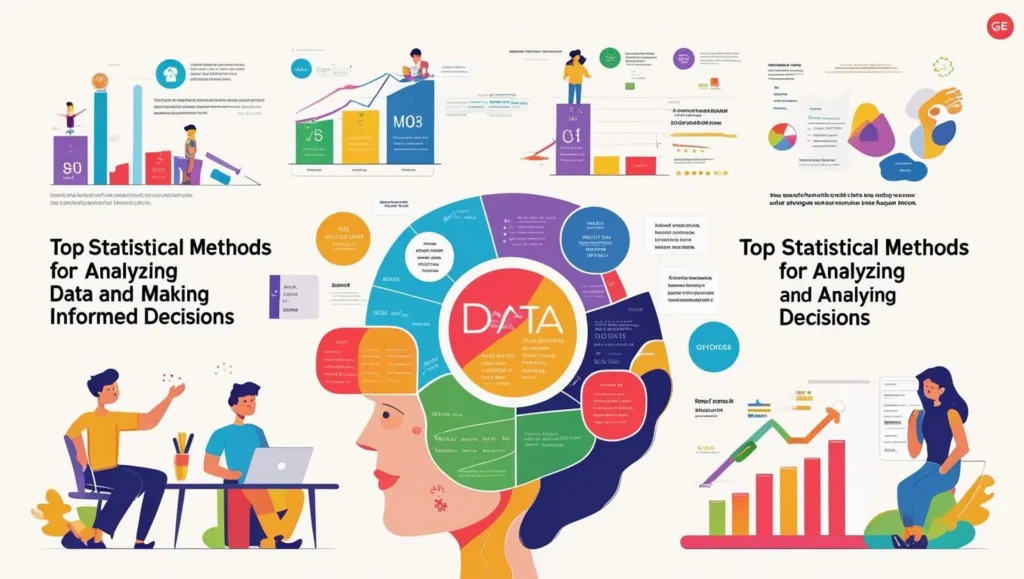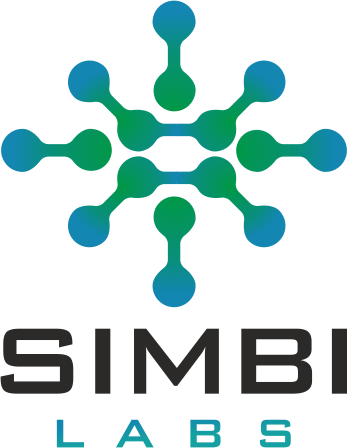“From Data to Decisions: Mastering Key Statistical Tools”

In today’s data-rich world, simply having data isn’t enough; the true power lies in being able to analyze it effectively to extract meaningful insights and make smart, evidence-based decisions. Statistical methods provide the robust framework for understanding patterns, predicting future trends, and testing hypotheses. This blog post explores some of the most crucial statistical methods that empower businesses, researchers, and individuals to turn raw data into actionable intelligence.
1. Descriptive Statistics – The Starting Point
Before diving into complex analyses, you need to understand the fundamental characteristics of your data. Descriptive statistics are your first glance, summarizing and organizing data in a way that makes sense. They help you grasp the central tendencies (where your data clusters around) and the variability (how spread out your data is). Key tools here include calculating the mean (average), median (middle value), and mode (most frequent value) to understand central points, and range, variance, and standard deviation to measure dispersion.
Why it’s crucial for decisions:
Imagine you’re analyzing customer feedback. Descriptive statistics can quickly tell you the average satisfaction rating, the most common complaint category, and how varied customer experiences are. This immediate snapshot helps prioritize issues and understand overall sentiment without getting lost in individual responses.
Real Life Application:
A retail company uses descriptive statistics to analyze monthly sales data. They calculate the average sales per customer, identify the most popular product category (mode), and determine the range of daily transactions. This helps their management team understand typical customer spending habits, pinpoint peak sales periods, and make quick decisions on inventory replenishment or promotional strategies.
2. Inferential Statistics – Drawing Conclusions
While descriptive statistics describe your observed data, inferential statistics takes it a step further: it allows you to make informed guesses or draw conclusions about a larger population based on a smaller sample of data. This is fundamental for generalizing findings. Techniques like hypothesis testing help you determine if an observed effect or relationship in your sample is likely to exist in the broader population, and confidence intervals provide a range within which a true population parameter is likely to fall.
Why it’s crucial for decisions:
If a marketing team tests a new ad campaign on a segment of their customers, inferential statistics can determine if the positive results observed in that sample are significant enough to warrant rolling out the campaign to all customers. This prevents costly decisions based on chance variations.
Real Life Application:
A pharmaceutical company conducts a clinical trial on a new drug, administering it to a sample of patients. Using inferential statistics, they compare the health outcomes of this sample group versus a placebo group. Based on their findings, they can infer whether the drug is likely to be effective and safe for the larger patient population, justifying its potential approval and widespread use.
3. Correlation and Association – Measuring Relationships

Correlation and association methods help you understand if and how two variables move together. A correlation coefficient (like Pearson’s r) quantifies the strength and direction of a linear relationship between two continuous variables. For example, a strong positive correlation between advertising spend and sales might suggest that as advertising increases, sales also tend to increase. It’s vital to remember the adage: “correlation does not imply causation.” Just because two things are related doesn’t mean one causes the other.
Why it’s crucial for decisions:
By identifying correlations, businesses can uncover potential links. For instance, finding a strong correlation between customer loyalty and product feature usage could lead a product development team to focus on enhancing those specific features to boost loyalty.
Real Life Application:
An HR department observes a strong positive correlation between employee training hours and their quarterly performance review scores. While this doesn’t definitively prove that more training causes higher performance (other factors might be involved), it strongly suggests a beneficial relationship, prompting the HR team to justify continued investment in employee development programs.
4. Multivariate Analysis – Studying Many Variables Together
Multivariate analysis (MVA) encompasses a suite of statistical techniques designed to analyze data with observations on multiple variables at once. These methods help uncover complex relationships, identify underlying structures, reduce data dimensionality, or group similar observations. Examples include Principal Component Analysis (PCA) for simplifying complex datasets, and Cluster Analysis for segmenting customers based on various characteristics.
Why it’s crucial for decisions:
An insurance company might use MVA to analyze customer demographics, claim history, and policy types simultaneously to identify distinct risk segments, leading to more accurate premium pricing and targeted marketing strategies.
Real Life Application:
A telecommunications company performs a customer segmentation analysis using multiple variables like call duration, data usage, service type, and billing history. Through multivariate clustering techniques, they identify distinct customer groups (e.g., “heavy data streamers,” “budget callers,” “international users”), allowing them to design differentiated service packages and highly targeted marketing campaigns for each segment.
5. Regression Analysis – Predicting Outcomes
Often, real-world phenomena are influenced by numerous factors interacting simultaneously. Multivariate analysis (MVA) encompasses a suite of statistical techniques designed to analyze data with observations on multiple variables at once. These methods help uncover complex relationships, identify underlying structures, reduce data dimensionality, or group similar observations. Examples include Principal Component Analysis (PCA) for simplifying complex datasets, and Cluster Analysis for segmenting customers based on various characteristics.
Why it’s crucial for decisions:
An insurance company might use MVA to analyze customer demographics, claim history, and policy types simultaneously to identify distinct risk segments, leading to more accurate premium pricing and targeted marketing strategies.
Real Life Application:
A telecommunications company performs a customer segmentation analysis using multiple variables like call duration, data usage, service type, and billing history. Through multivariate clustering techniques, they identify distinct customer groups (e.g., “heavy data streamers,” “budget callers,” “international users”), allowing them to design differentiated service packages and highly targeted marketing campaigns for each segment.
6. Non-Parametric Techniques – For Data That Doesn’t Fit Assumptions
Many classical statistical methods (like t-tests or ANOVA) rely on specific assumptions about the data’s distribution, often assuming normality. However, not all data fits these molds. Non-parametric techniques are statistical methods that do not require these strict distributional assumptions. They are particularly useful for ordinal data (ranked data), small sample sizes, or data that is clearly skewed or irregular. Examples include the Mann-Whitney U test (alternative to the independent t-test) and the Kruskal-Wallis test (alternative to ANOVA).
Why it’s crucial for decisions:
If a patient satisfaction survey yields ordinal data (e.g., “Very Dissatisfied” to “Very Satisfied”) that isn’t normally distributed, non-parametric tests can still reliably compare satisfaction levels between different hospital departments, ensuring valid conclusions even with unconventional data.
Real Life Application:
A small startup conducts a pilot user experience study with a limited number of participants (e.g., 15 people), asking them to rank the ease of use of five different app prototypes on an ordinal scale. Since the sample size is small and the data is ranked (not truly interval), they use a non-parametric test like the Friedman test to determine if there’s a significant difference in perceived ease of use among the prototypes, enabling them to choose the best design for further development.
7. Data Mining & Machine Learning Techniques (Built on Statistical Foundations)

While often considered a separate field, data mining and machine learning (ML) heavily leverage statistical foundations to build predictive models and discover patterns in large datasets. Techniques like decision trees, support vector machines, neural networks, and clustering algorithms (many of which have roots in multivariate statistics) automate the process of finding insights and making predictions from vast amounts of data. They allow for the creation of sophisticated algorithms that learn from data without being explicitly programmed
Why it’s crucial for decisions:
E-commerce companies use ML algorithms for personalized product recommendations, significantly boosting sales. Banks employ ML for fraud detection, flagging suspicious transactions in real-time. These automated systems, built on statistical principles, enable rapid, high-volume decision-making that would be impossible manually.
Real Life Application:
A financial institution deploys a machine learning model for real-time credit card fraud detection. The model is trained on millions of historical transactions, learning patterns of legitimate versus fraudulent spending. When a new transaction occurs, the ML model, using its statistical understanding of past data, instantly assigns a fraud probability score, flagging suspicious ones for immediate review and preventing significant financial losses
Managing Missing Data for Accurate Analysis
In many datasets, missing values can pose significant challenges. Handling missing data appropriately is vital for ensuring accurate analysis. Some methods used to handle missing data include:
- MAR (Missing at Random): The absence of data is related to some observed variables but not to the unobserved data itself.
- MNAR (Missing Not at Random): The absence of data is related to the unobserved data itself.
Common Techniques to Handle Missing Data:
- Listwise Deletion: Eliminates rows containing any missing values.
- Mean/Median/Mode Imputation: Replaces missing numerical data with the mean or median, and categorical data with the mode.
- K-Nearest Neighbors (KNN) Imputation: Fills in missing values by using similar data points from neighboring records.
Conclusion: Applying Statistical Techniques for Effective Data Analysis
Statistical techniques act like tools in a toolbox, each one suited to a specific problem or scenario. Whether you’re analyzing customer satisfaction, climate data, or social behavior, there’s always a statistical method designed to help uncover valuable insights. By choosing the right technique for the task at hand, you can make data-driven decisions that lead to better outcomes.
Statistical methods are the backbone of data-driven decision-making. From initially summarizing your data with descriptive statistics to drawing broad conclusions with inferential methods, understanding relationships through correlation and regression, handling complexity with multivariate analysis, adapting to non-ideal data with non-parametric techniques, and finally, leveraging advanced data mining and machine learning, each method plays a vital role. By mastering these tools, you transform raw information into valuable insights, enabling you to navigate the complexities of data and make truly informed decisions in any field.
Statistical Methods Quiz
1. Which statistical method is primarily used for organizing, summarizing, and describing the main features of a dataset?
A) Inferential Statistics
B) Regression Analysis
C) Descriptive Statistics
D) Multivariate Analysis
2. If you want to use a sample to make generalizations or predictions about a larger population, which branch of statistics would you primarily use?
A) Descriptive Statistics
B) Inferential Statistics
C) Non-Parametric Techniques
D) Data Mining
3. What does a high positive correlation between two variables indicate?
A) One variable causes the other to increase.
B) As one variable increases, the other also tends to increase.
C) The variables are completely unrelated.
D) The data has a normal distribution.
4. Which statistical method is used to build a mathematical equation to predict an outcome variable based on one or more predictor variables?
A) Correlation Analysis
B) Descriptive Statistics
C) Regression Analysis
D) Non-Parametric Techniques
5. You have a dataset with many interconnected variables and you want to reduce the number of variables while retaining most of the information, or group observations based on multiple traits. Which category of methods would you explore?
A) Inferential Statistics
B) Regression Analysis
C) Non-Parametric Techniques
D) Multivariate Analysis
6. Which statistical techniques are preferred when your data does not meet strict distributional assumptions (e.g., not normally distributed) or when working with ordinal data?
A) Parametric Tests
B) Regression Analysis
C) Non-Parametric Techniques
D) Correlation Analysis
7. The mean, median, and mode are examples of which type of statistical measure?
A) Measures of Dispersion
B) Measures of Central Tendency
C) Measures of Correlation
D) Measures of Inference
8. The statement “correlation does not imply causation” is a crucial caution when interpreting results from which method?
A) Regression Analysis
B) Correlation and Association
C) Descriptive Statistics
D) Non-Parametric Techniques
9. Which advanced field heavily leverages statistical foundations to build predictive models and discover patterns in very large datasets, often without explicit programming for each rule?
A) Descriptive Statistics
B) Inferential Statistics
C) Data Mining & Machine Learning Techniques
D) Multivariate Analysis
10. You want to determine if a new fertilizer significantly increases crop yield compared to an old one, based on a test on a small plot of land. Which statistical concept would you use to generalize your findings to larger fields?
A) Descriptive Statistics
B) Correlation Analysis
C) Inferential Statistics
D) Data Cleaning
👉 Contact Simbi Labs today to schedule a free consultation and start your data transformation journey!
